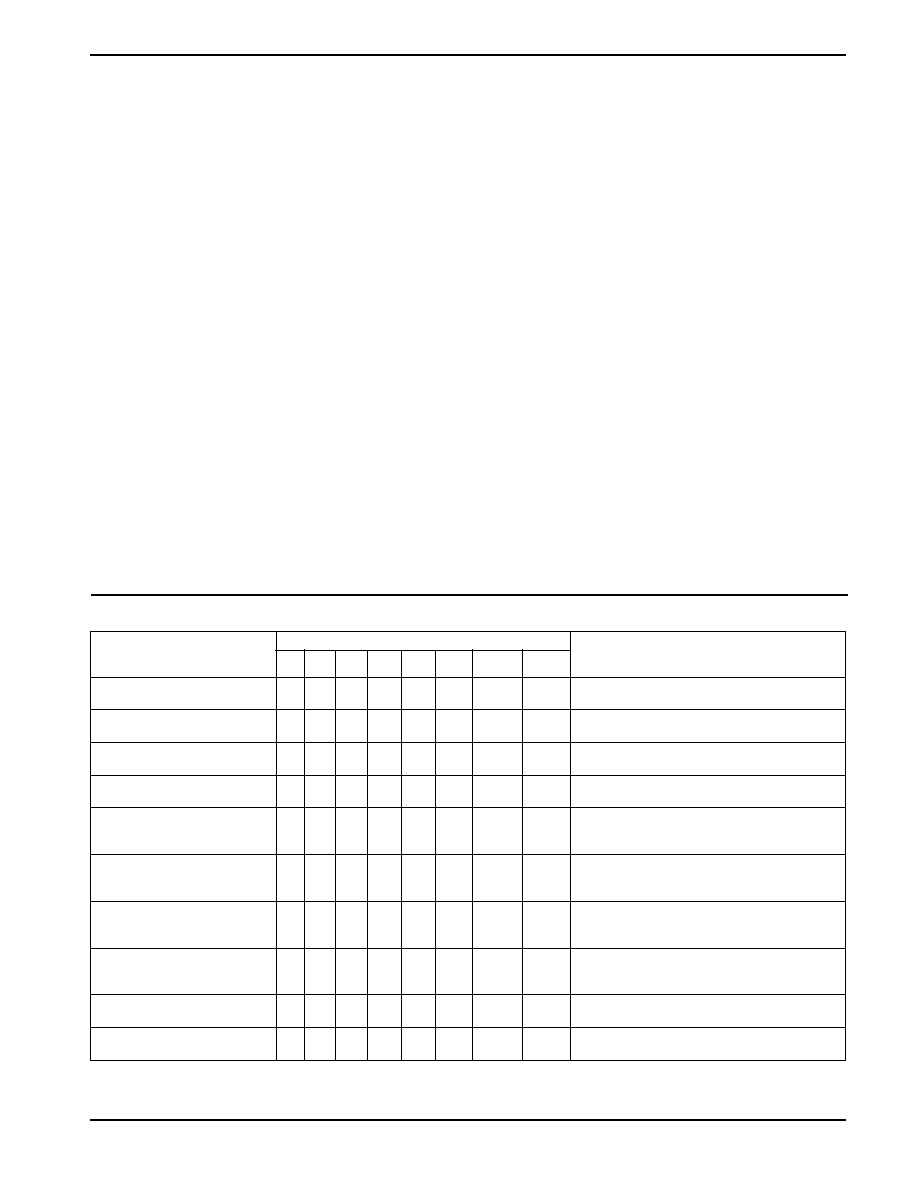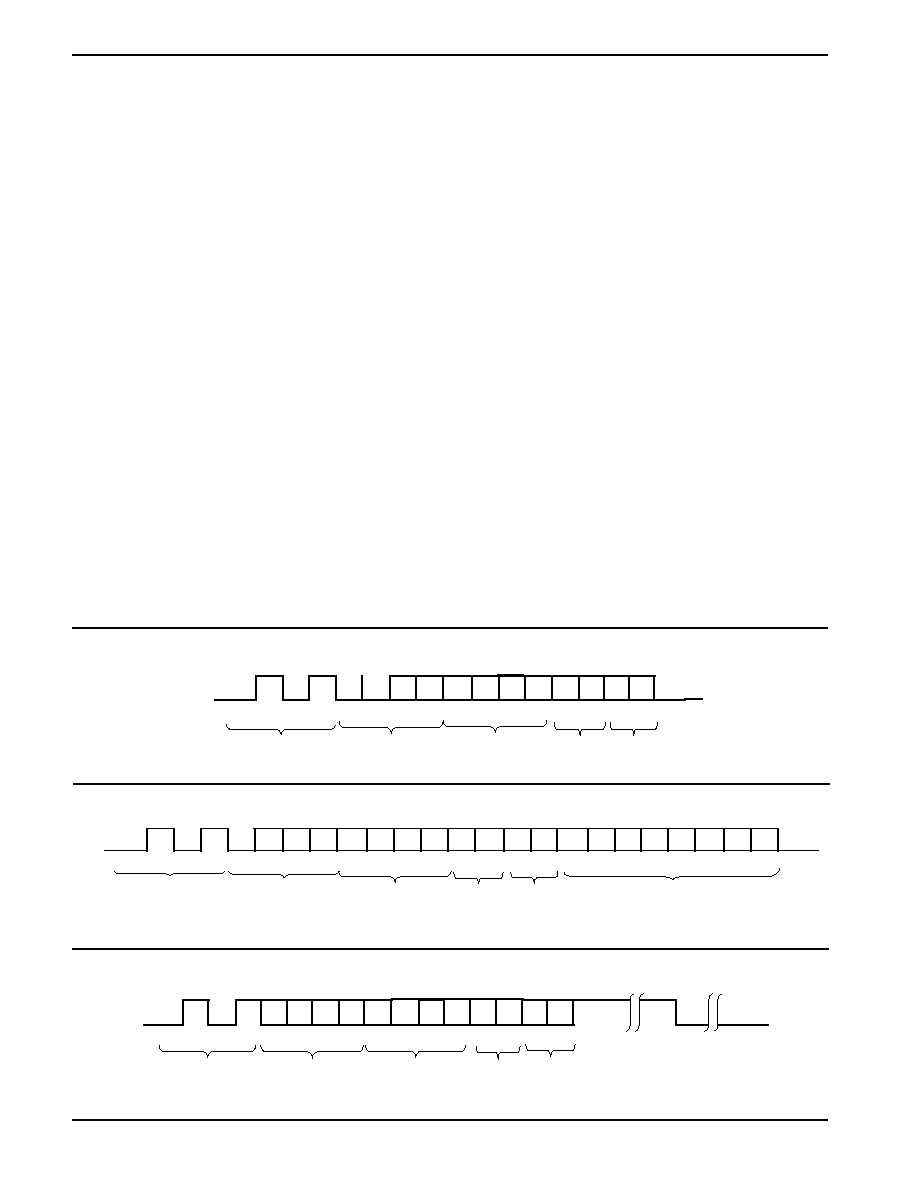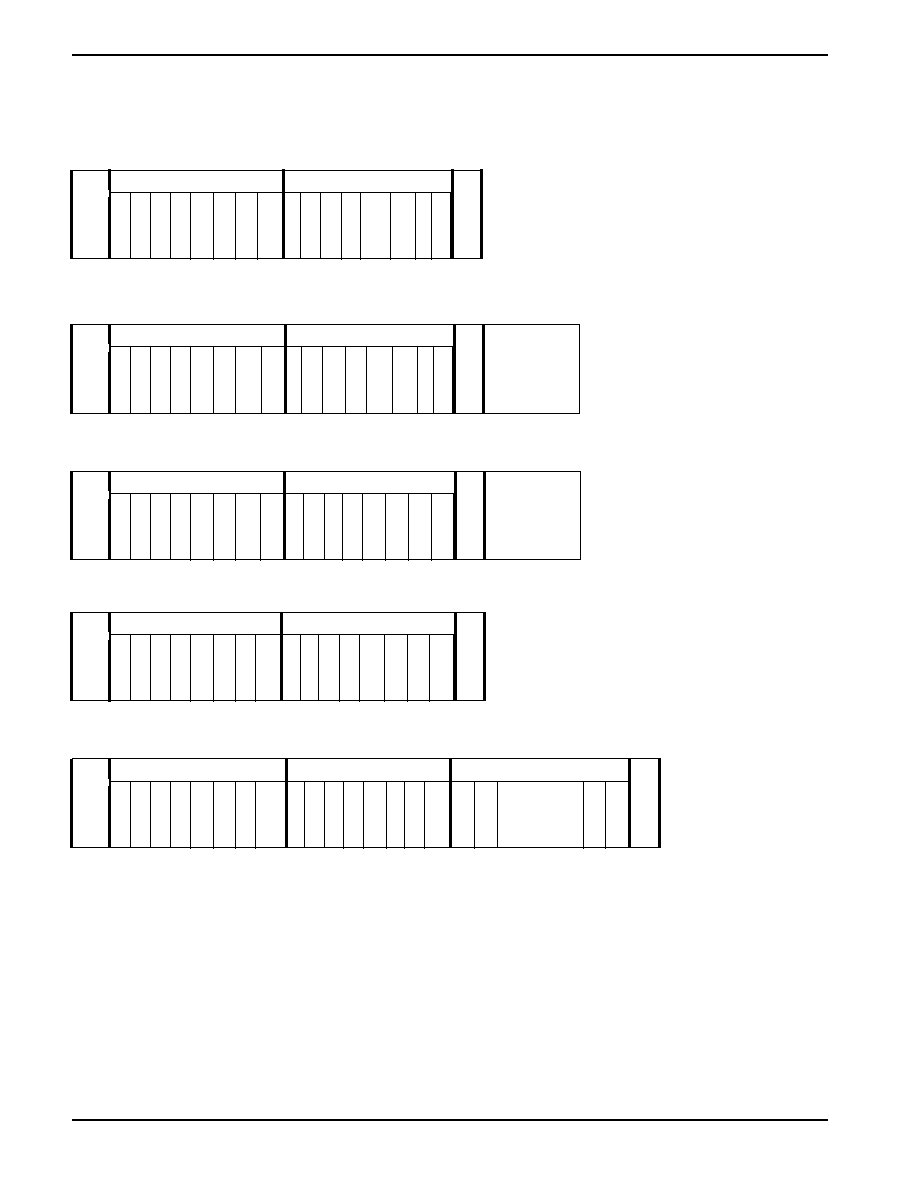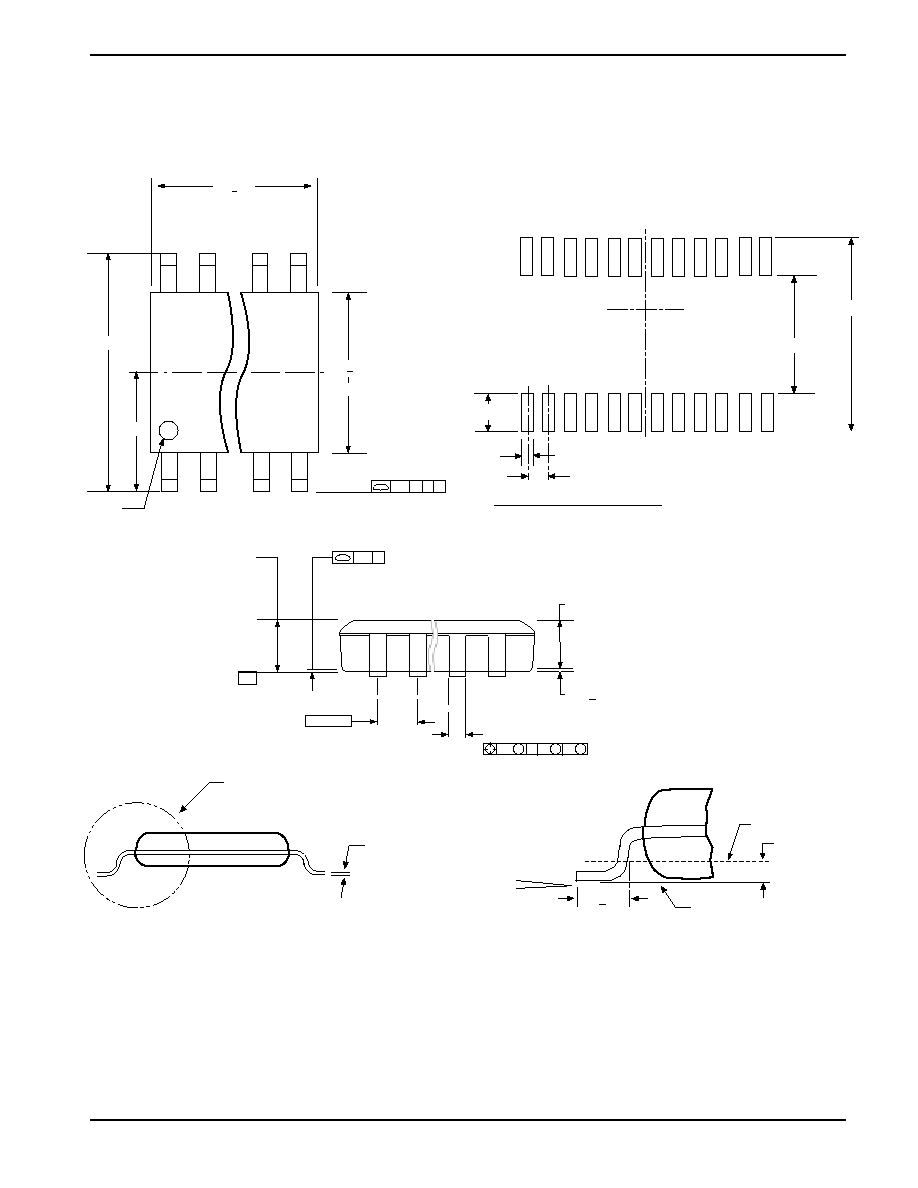
1
DESCRIPTION
The CAT5401 is four Digitally Programmable
Potentiometers (DPPsTM) integrated with control logic
and 16 bytes of NVRAM memory. Each DPP consists of
a series of 63 resistive elements connected between two
externally accessible end points. The tap points between
each resistive element are connected to the wiper outputs
with CMOS switches. A separate 6-bit control register
(WCR) independently controls the wiper tap switches for
each DPP. Associated with each wiper control register
are four 6-bit non-volatile memory data registers (DR)
used for storing up to four wiper settings. Writing to the
CAT5401
Quad Digitally Programmable Potentiometers (DPPTM)
with 64 Taps and SPI Interface
FEATURES
s
Four linear-taper digitally programmable
potentiometers
s
64 resistor taps per potentiometer
s
End to end resistance 2.5k
, 10k
, 50k
or 100k
s
Potentiometer control and memory access via
SPI interface: Mode (0, 0) and (1, 1)
s
Low wiper resistance, typically 80
s
Nonvolatile memory storage for up to four wiper
settings for each potentiometer
s
Automatic recall of saved wiper settings at
power up
s
2.5 to 6.0 volt operation
s
Standby current less than 1
�
A
s
1,000,000 nonvolatile WRITE cycles
s
100 year nonvolatile memory data retention
s
24-lead SOIC, 24-lead TSSOP and BGA
s
Industrial temperature range
PIN CONFIGURATION
FUNCTIONAL DIAGRAM
� 2004 by Catalyst Semiconductor, Inc.
Characteristics subject to change without notice
Document No. 2010, Rev. F
wiper control register or any of the non-volatile data
registers is via a SPI serial bus. On power-up, the
contents of the first data register (DR0) for each of the
four potentiometers is automatically loaded into its
respective wiper control register.
The CAT5401 can be used as a potentiometer or as a
two terminal, variable resistor. It is intended for circuit
level or system level adjustments in a wide variety of
applications.
BGA
Top View - Bump Side Down
R
H0
W0
W2
W3
W1
H1
H2
H3
R
R
R
R
L0
L1
L2
L3
R R
R
WIPER
CONTROL
REGISTERS
NONVOLATILE
DATA
REGISTERS
SPI BUS
INTERFACE
CONTROL
LOGIC
SCK
SI
WP
A0
A1
R
R
R
R
CS
SO
HA
LOGEN FREE
TM
LEAD FREE
1 2 3 4
A
B
C
D
E
F
RW0
CS
A1
RL1
RL0
WP
SI
RW1
VCC
RH0
RH1
VSS
NC
RH3
RH2
NC
RL3
SO
HOLD
RW2
RW3
A0
SCK
RL2
24
23
22
21
20
19
18
17
16
15
14
13
1
2
3
4
5
6
7
8
9
10
11
12
CAT
5401
VCC
RL0
RH0
RW0
CS
WP
SI
A1
RL1
RH1
RW1
GND
NC
RL3
RH3
RW3
A0
SO
HOLD
SCK
RL2
RH2
RW2
NC
24
23
22
21
20
19
18
17
16
15
14
13
1
2
3
4
5
6
7
8
9
10
11
12
CAT
5401
SI
A1
RL1
RH1
RW1
GND
NC
RW2
RH2
RL2
SCK
HOLD
WP
CS
RW0
RH0
RL0
VCC
NC
RL3
RH3
RW3
A0
SO
SOIC Package (J, W)
TSSOP Package (U, Y)

2
CAT5401
Document No. 2010, Rev. F
WP
WP
WP
WP
WP
:
Write Protect
WP
is the Write Protect pin. The Write Protect pin will allow normal read/write operations when held high. When
WP
is tied low, all
non-volatile write operations to the Data registers are inhibited (change of wiper control register is allowed).
WP
going low while
CS is still low will interrupt a write to the registers. If the internal write cycle has already been initiated,
WP
going low will have no
effect on any write operation.
HOLD
HOLD
HOLD
HOLD
HOLD
:
Hold
The
HOLD
pin is used to pause transmission to the CAT5401 while in the middle of a serial sequence without having to re-
transmit entire sequence at a later time. To pause,
HOLD
must be brought low while SCK is low. The SO pin is in a high imped-
ance state during the time the part is paused, and transitions on the SI pins will be ignored. To resume communication,
HOLD
is
brought high, while SCK is low. (
HOLD
should be held high any time this function is not being used.)
HOLD
may be tied high
directly to VCC or tied to VCC through a resistor.
PIN DESCRIPTION
Pin
Pin
Pin
(SOIC)
(TSSOP) (BGA) Name
Function
1
19
C1
VCC
Supply Voltage
2
20
B1
R
L0
Low Reference Terminal
for Potentiometer 0
3
21
C2
R
H0
High Reference Terminal
for Potentiometer 0
4
22
A1
R
W0
Wiper Terminal for Potentiometer 0
5
23
A2
CS
Chip Select
6
24
B2
WP
Write Protection
7
1
B3
SI
Serial Input
8
2
A3
A1
Device Address
9
3
A4
R
L1
Low Reference Terminal
for Potentiometer 1
10
4
C3
R
H1
High Reference Terminal
for Potentiometer 1
11
5
B4
R
W1
Wiper Terminal for Potentiometer 1
12
6
C4
GND
Ground
13
7
D4
NC
No Connect
14
8
E4
R
W2
Wiper Terminal for
Potentiometer 2
15
9
D3
R
H2
High Reference Terminal
for Potentiometer 2
16
10
F4
R
L2
Low Reference Terminal
for Potentiometer 2
17
11
F3
SCK
Bus Serial Clock
18
12
E3
HOLD
Hold
19
13
E2
SO
Serial Data Output
20
14
F2
A0
Device Address, LSB
21
15
F1
R
W3
Wiper Terminal for Potentiometer 3
22
16
D2
R
H3
High Reference Terminal
for Potentiometer 3
23
17
E1
R
L3
Low Reference Terminal
for Potentiometer 3
24
18
D1
NC
No Connect
PIN DESCRIPTIONS
SI:
Serial Input
SI is the serial data input pin. This pin is used to input
all opcodes, byte addresses and data to be written to
the CAT5401. Input data is latched on the rising edge
of the serial clock.
SO:
Serial Output
SO is the serial data output pin. This pin is used to
transfer data out of the CAT5401. During a read
cycle, data is shifted out on the falling edge of the
serial clock.
SCK:
Serial Clock
SCK is the serial clock pin. This pin is used to
synchronize the communication between the
microcontroller and the CAT5401. Opcodes, byte
addresses or data present on the SI pin are latched
on the rising edge of the SCK. Data on the SO pin is
updated on the falling edge of the SCK.
A0, A1: Device Address Inputs
These inputs set the device address when address-
ing multiple devices. A total of four devices can be
addressed on a single bus. A match in the slave
address must be made with the address input in
order to initiate communication with the CAT5401.
R
H
, R
L
: Resistor End Points
The four sets of R
H
and R
L
pins are equivalent to the
terminal connections on a mechanical potentiometer.
R
W
:
Wiper
The four R
W
pins are equivalent to the wiper terminal
of a mechanical potentiometer.
CS
CS
CS
CS
CS
:
Chip Select
CS
is the Chip select pin.
CS
low enables the
CAT5401 and
CS
high disables the CAT5401.
CS
high
takes the SO output pin to high impedance and forces
the devices into a Standby mode (unless an internal
write operation is underway). The CAT5401 draws
ZERO current in the Standby mode. A high to low
transition on
CS
is required prior to any sequence
being initiated. A low to high transition on
CS
after a
valid write sequence is what initiates an internal write
cycle.

3
CAT5401
Document No. 2010, Rev. F
DEVICE OPERATION
The CAT5401 is four resistor arrays integrated with SPI
serial interface logic, four 6-bit wiper control registers
and sixteen 6-bit, non-volatile memory data registers.
Each resistor array contains 63 separate resistive
elements connected in series. The physical ends of
each array are equivalent to the fixed terminals of a
mechanical potentiometer (R
H
and R
L
). R
H
and
R
L
are
symmetrical and may be interchanged. The tap positions
between and at the ends of the series resistors are
connected to the output wiper terminals (R
W
) by a
CMOS transistor switch. Only one tap point for each
potentiometer is connected to its wiper terminal at a time
and is determined by the value of the wiper control
register. Data can be read or written to the wiper control
registers or the non-volatile memory data registers via
the SPI bus. Additional instructions allows data to be
transferred between the wiper control registers and
each respective potentiometer's non-volatile data
registers. Also, the device can be instructed to operate
in an "increment/decrement" mode.
SERIAL BUS PROTOCOL
The CAT5041 supports the SPI bus data transmission
protocol. The synchronous Serial Peripheral Interface
(SPI) helps the CAT5401 to interface directly with many
of today's popular microcontrollers. The CAT5041
contains an 8-bit instruction register .The instruction set
and the operation codes are detailed in the instruction
set table
3.
After the device is selected with
CS
going low the first
byte will be received. The part is accessed via the SI pin,
with data being clocked in on the rising edge of SCK. The
first byte contains one of the six op-codes that define the
operation to be performed.

4
CAT5401
Document No. 2010, Rev. F
Notes:
(1) This parameter is tested initially and after a design or process change that affects the parameter.
(2)
Absolute linearity is utilitzed to determine actual wiper voltage versus expected voltage as determined by wiper position when used as a potentiometer.
(3) Relative linearity is utilized to determine the actual change in voltage between two successive tap positions when used as a
potentiometer. It is a measure of the error in step size.
(4) LSB = R
TOT
/ 63 or (R
H
- R
L
) / 63, single pot
(5) n = 0, 1, 2, ..., 63
ABSOLUTE MAXIMUM RATINGS*
Temperature Under Bias .................. -55
�
C to +125
�
C
Storage Temperature ........................ -65
�
C to +150
�
C
Voltage on any Pin with
Respect to V
SS
(1)
................... -2.0V to +V
CC
+2.0V
V
CC
with Respect to Ground ................ -2.0V to +7.0V
Package Power Dissipation
Capability (T
A
= 25
�
C) ................................... 1.0W
Lead Soldering Temperature (10 secs) ............ 300
�
C
Wiper Current .................................................. +12mA
Notes:
(1) The minimum DC input voltage is �0.5V. During transitions, inputs may undershoot to �2.0V for periods of less than 20 ns. Maximum DC voltage on output
pins is V
CC
+0.5V, which may overshoot to V
CC
+2.0V for periods of less than 20 ns.
(2) Latch-up protection is provided for stresses up to 100 mA on address and data pins from �1V to V
CC
+1V.
*COMMENT
Stresses above those listed under "Absolute Maximum Ratings" may cause permanent
damage to the device. These are stress ratings only, and functional operation of the
device at these or any other conditions outside of those listed in the operational sections
of this specification is not implied. Exposure to any absolute maximum rating for extended
periods may affect device performance and reliability.
Recommended Operating Conditions:
V
CC
= +2.5V to +6.0V
Temperature
Min
Max
Industrial
-40
�
C
85
�
C
POTENTIOMETER CHARACTERISTICS
Over recommended operating conditions unless otherwise stated.
Symbol
Parameter
Test Conditions
Min
Typ
Max
Units
R
POT
Potentiometer Resistance (-00
)
100
k
R
POT
Potentiometer Resistance (-50
)
50
k
R
POT
Potentiometer Resistance (-10
)
10
k
R
POT
Potentiometer Resistance (-2.5
)
2.5
k
Potentiometer Resistance Tolerance
+20
%
R
POT
Matching
1
%
Power Rating
25
�
C, each pot
50
mW
I
W
Wiper Current
+6
mA
R
W
Wiper Resistance
I
W
= +3mA @ V
CC
=3V
300
R
W
Wiper Resistance
I
W
= +3mA @ V
CC
= 5V
80
150
V
TERM
Voltage on any R
H
or R
L
Pin
V
SS
= 0V
GND
V
CC
V
V
N
Noise
(1)
TBD
nV/ Hz
Resolution
(1)
1.6
%
Absolute Linearity
(2)
R
w(n)(actual)
-R
(n)(expected)
(5)
+1
LSB
(4)
Relative Linearity
(3)
R
w(n+1)
-[R
w(n)+LSB
]
(5)
+0.2
LSB
(4)
TC
RPOT
Temperature Coefficient of R
POT
(1)
+300
ppm/
�
C
TC
RATIO
Ratiometric Temp. Coefficient
(1)
20
ppm/
�
C
C
H
/C
L
/C
W
Potentiometer Capacitances
(1)
10/10/25
pF
fc
Frequency Response
R
POT
= 50k
0.4
MHz

5
CAT5401
Document No. 2010, Rev. F
D.C. OPERATING CHARACTERISTICS
Over recommended operating conditions unless otherwise stated.
Symbol
Parameter
Test Conditions
Min
Typ
Max
Units
I
CC
Power Supply Current
f
SCK
= 2MHz, SO Open
1
mA
Inputs = GND
I
SB
Standby Current (V
CC
= 5.0V)
V
IN
= GND or V
CC;
SO Open
1
�
A
I
LI
Input Leakage Current
V
IN
= GND to V
CC
10
�
A
I
LO
Output Leakage Current
V
OUT
= GND to V
CC
10
�
A
V
IL
Input Low Voltage
-1
V
CC
x 0.3
V
V
IH
Input High Voltage
V
CC
x 0.7
V
CC
+ 1.0
V
V
OL1
Output Low Voltage (V
CC
= 3.0V)
I
OL
= 3 mA
0.4
V
PIN CAPACITANCE
(1)
Applicable over recommended operating range from T
A
=25�C, f=1.0 MHz, VCC=+5.0V (unless otherwise noted).
Symbol
Test Conditions
Min
Typ
Max
Units
Conditions
C
OUT
Output Capacitance (SO)
8
pF
V
OUT
=0V
C
IN
Input Capacitance (
CS
, SCK, SI,
WP
,
HOLD
)
6
pF
V
IN
=0V

6
CAT5401
Document No. 2010, Rev. F
Test
SYMBOL
PARAMETER
Min
Typ
Max
UNITS
Conditions
t
SU
Data Setup Time
50
ns
t
H
Data Hold Time
50
ns
t
WH
SCK High Time
125
ns
t
WL
SCK Low Time
125
ns
f
SCK
Clock Frequency
DC
3
MHz
t
LZ
HOLD
to Output Low Z
50
ns
t
RI
(1)
Input Rise Time
2
�
s
t
FI
(1)
Input Fall Time
2
�
s
t
HD
HOLD
Setup Time
100
ns
t
CD
HOLD
Hold Time
100
ns
t
WC
Write Cycle Time
10
ms
t
V
Output Valid from Clock Low
250
ns
t
HO
Output Hold Time
0
ns
t
DIS
Output Disable Time
250
ns
t
HZ
HOLD
to Output High Z
100
ns
t
CS
CS
High Time
250
ns
t
CSS
CS
Setup Time
250
ns
t
CSH
CS
Hold Time
250
ns
NOTE:
(1) This parameter is tested initially and after a design or process change that affects the parameter.
Note:
(1) This parameter is tested initially and after a design or process change that affects the parameter.
POWER UP TIMING
(1)
Over recommended operating conditions unless otherwise stated.
Symbol
Parameter
Min
Typ
Max
Units
t
PUR
Power-up to Read Operation
1
ms
t
PUW
Power-up to Write Operation
1
ms
A.C. CHARACTERISTICS
Over recommended operating conditions unless otherwise stated.
C
L
= 50pF

7
CAT5401
Document No. 2010, Rev. F
WRITE CYCLE LIMITS
Over recommended operating conditions unless otherwise stated.
Symbol
Parameter
Min
Typ
Max
Units
t
WR
Write Cycle Time
5
ms
Figure 1. Sychronous Data Timing
Figure 2.
HOLD
HOLD
HOLD
HOLD
HOLD
Timing
Note:
(1) This parameter is tested initially and after a design or process change that affects the parameter.
(2) t
PUR
and t
PUW
are the delays required from the time V
CC
is stable until the specified operation can be initiated.
(3) Dashed Line= mode (1, 1) -- -- -- --
RELIABILITY CHARACTERISTICS
Over recommended operating conditions unless otherwise stated.
Symbol
Parameter
Reference Test Method
Min
Typ
Max
Units
N
END
(1)
Endurance
MIL-STD-883, Test Method 1033
1,000,000
Cycles/Byte
T
DR
(1)
Data Retention
MIL-STD-883, Test Method 1008
100
Years
V
ZAP
(1)
ESD Susceptibility
MIL-STD-883, Test Method 3015
2000
Volts
I
LTH
(1)
Latch-Up
JEDEC Standard 17
100
mA
VALID IN
V
IH
V
IL
t
CSS
V
IH
V
IL
V
IH
VIL
V
OH
V
OL
HI-Z
t
SU
t
H
t
WH
t
WL
t
V
t
CS
t
CSH
t
HO
t
DIS
HI-Z
CS
SCK
SI
SO
t
RI
tFI
CS
SCK
HOLD
SO
tCD
tHD
tHD
tCD
tLZ
tHZ
HIGH IMPEDANCE

8
CAT5401
Document No. 2010, Rev. F
INSTRUCTION AND REGISTER
DESCRIPTION
DEVICE TYPE / ADDRESS BYTE
The first byte sent to the CAT5401 from the master/
processor is called the Device Address Byte. The most
significant four bits of the Device Type address are a
device type identifier. These bits for the CAT5401 are
fixed at 0101[B] (refer to Table 1).
The two least significant bits in the slave address byte,
A1 - A0, are the internal slave address and must match
the physical device address which is defined by the state
of the A1 - A0 input pins for the CAT5401 to successfully
continue the command sequence. Only the device which
slave address matches the incoming device address
sent by the master executes the instruction. The A1 - A0
inputs can be actively driven by CMOS input signals or
tied to V
CC
or V
SS
. The remaining two bits in the device
address byte must be set to 0.
INSTRUCTION BYTE
The next byte sent to the CAT5401 contains the instruction
and register pointer information. The four most significant
bits used provide the instruction opcode I [3:0]. The R1
and R0 bits point to one of the four data registers of each
associated potentiometer. The least two significant bits
point to one of four Wiper Control Registers. The format
is shown in Table 2.
Table 1. Identification Byte Format
ID3
ID2
ID1
ID0
0
0
A1
A0
0
1
0
1
(MSB)
(LSB)
Device Type
Identifier
Slave Address
Table 2. Instruction Byte Format
I3
I2
I1
I0
R1
R0
P1
P0
(MSB)
(LSB)
Instruction
Data Register
WCR/Pot Selection
Opcode
Selection
Data Register Selected
R1
R0
DR0
0
0
DR1
0
1
DR2
1
0
DR3
1
1
Data Register Selection

9
CAT5401
Document No. 2010, Rev. F
Table 3. Instruction Set
WIPER CONTROL AND DATA REGISTERS
Wiper Control Register (WCR)
The CAT5401 contains four 6-bit Wiper Control
Registers, one for each potentiometer. The Wiper
Control Register output is decoded to select one of 64
switches along its resistor array. The contents of the
WCR can be altered in four ways: it may be written by
the host via Write Wiper Control Register instruction;
it may be written by transferring the contents of one of
four associated Data Registers via the XFR Data
Register instruction, it can be modified one step at a
time by the Increment/decrement instruction (see
Instruction section for more details). Finally, it is
loaded with the content of its data register zero (DR0)
upon power-up.
The Wiper Control Register is a volatile register that
loses its contents when the CAT5401 is powered-down.
Although the register is automatically loaded with the
value in DR0 upon power-up, this may be different from
the value present at power-down.
Data Registers (DR)
Each potentiometer has four 6-bit non-volatile Data
Registers. These can be read or written directly by the
host. Data can also be transferred between any of the
four Data Registers and the associated Wiper Control
Register. Any data changes in one of the Data Registers
is a non-volatile operation and will take a maximum of
5ms.
Write in Process
The contents of the Data Registers are saved to
nonvolatile memory when the CS input goes HIGH after
a write sequence is received. The status of the internal
write cycle can be monitored by issuing a Read Status
command to read the Write in Process (WIP) bit.
INSTRUCTIONS
Five of the ten instructions are three bytes in length.
These instructions are:
--
Read Wiper Control Register
- read the current
wiper position of the selected potentiometer in the WCR
-- Write Wiper Control Register - change current
wiper position in the WCR of the selected potentiometer
-- Read Data Register - read the contents of the
selected Data Register
-- Write Data Register - write a new value to the
selected Data Register
-- Read Status - Read the status of the WIP bit which
Note:
1/0 = data is one or zero
Instruction
Instruction Set
Operation
I3
I2
I1
I0
R1
R0
WCR1/
P1
Read Wiper Control
Register
1
0
0
1
0
0
1/0
1/0
Read the contents of the Wiper Control
Register pointed to by P1-P0
Write Wiper Control Register
1
0
1
0
0
0
1/0
1/0
Write new value to the Wiper Control
Register pointed to by P1-P0
Read Data Register
1
0
1
1
1/0
1/0
1/0
1/0
Read the contents of the Data Register
pointed to by P1-P0 and R1-R0
Write Data Register
1
1
0
0
1/0
1/0
1/0
1/0
Write new value to the Data Register
pointed to by P1-P0 and R1-R0
XFR Data Register to Wiper
Control Register
1
1
0
1
1/0
1/0
1/0
1/0
Transfer the contents of the Data Register
pointed to by P1-P0 and R1-R0 to its
associated Wiper Control Register
XFR Wiper Control Register
to Data Register
1
1
1
0
1/0
1/0
1/0
1/0
Transfer the contents of the Wiper Control
Register pointed to by P1-P0 to the Data
Register pointed to by R1-R0
Global XFR Data Registers
to Wiper Control Registers
0
0
0
1
1/0
1/0
0
0
Transfer the contents of the Data Registers
pointed to by R1-R0 of all four pots to their
respective Wiper Control Register
s
Global XFR Wiper Control
Registers to Data Register
1
0
0
0
1/0
1/0
0
0
Transfer the contents of both Wiper Control
Registers to their respective data Registers
pointed to by R1-R0 of all four pots
Increment/Decrement Wiper
Control Register
0
0
1
0
0
0
1/0
1/0
Enable Increment/decrement of the Control
Latch pointed to by P1-P0
WCR0/
P0
Read Status (WIP bit)
0
1
0
1
0
0
0
1
Read WIP bit to check internal
write cycle status

10
CAT5401
Document No. 2010, Rev. F
when set to "1" signifies a write cycle is in progress.
The basic sequence of the three byte instructions is
illustrated in Figure 8. These three-byte instructions
exchange data between the WCR and one of the Data
Registers. The WCR controls the position of the wiper.
The response of the wiper to this action will be delayed
by t
WRL
. A transfer from the WCR (current wiper position),
to a Data Register is a write to non-volatile memory and
takes a minimum of t
WR
to complete. The transfer can
occur between one of the four potentiometers and one
of its associated registers; or the transfer can occur
between all potentiometers and one associated register.
Four instructions require a two-byte sequence to
complete, as illustrated in Figure 7. These instructions
transfer data between the host/processor and the
CAT5401; either between the host and one of the data
registers or directly between the host and the Wiper
Control Register. These instructions are:
--
XFR Data Register to Wiper Control Register
This transfers the contents of one specified Data
Register to the associated Wiper Control Register.
-- XFR Wiper Control Register to Data Register
This transfers the contents of the specified Wiper
Control Register to the specified associated
Data Register.
-- Global XFR Data Register to Wiper
Control Register
This transfers the contents of all specified Data
Registers to the associated Wiper Control
Registers.
-- Global XFR Wiper Counter Register to
Data Register
This transfers the contents of all Wiper Control
Registers to the specified associated Data
Registers.
INCREMENT/DECREMENT COMMAND
The final command is Increment/Decrement (Figure 5
and 9). The Increment/Decrement command is different
from the other commands. Once the command is issued
the master can clock the selected wiper up and/or down
in one segment steps; thereby providing a fine tuning
capability to the host. For each SCK clock pulse (t
HIGH
)
while SI is HIGH, the selected wiper will move one
resistor segment towards the R
H
terminal. Similarly, for
each SCK clock pulse while SI is LOW, the selected
wiper will move one resistor segment towards the R
L
terminal.
See Instructions format for more detail.
Figure 7. Two-Byte Instruction Sequence
Figure 8. Three-Byte Instruction Sequence
Figure 9. Increment/Decrement Instruction Sequence
0
1
0
1
A2
A0
I2
I1
I0
R1 R0 P1
SI
ID3 ID2 ID1 ID0
P0
Device ID
Internal
Instruction
Opcode
Address
Register
Address
Pot/WCR
Address
A1
A3
I3
0
0
I3
I2
I1
I0
R1 R0
ID3 ID2 ID1 ID0
Device ID
Internal
Instruction
Opcode
Address
Data
Register
Address
Pot/WCR
Address
WCR[7:0]
or
Data Register D[7:0]
0
1
0
1
A2
A1
A0
P1 P0
SI
D7
D6 D5 D4
D3 D2
D1 D0
A3
I3
I2
I1
I0
ID3 ID2 ID1 ID0
Device ID
Internal
Instruction
Opcode
Address
Data
Register
Address
Pot/WCR
Address
0
1
0
1
A2 A1 A0
R0 P1 P0
SI
I
N
C
1
I
N
C
2
I
N
C
n
D
E
C
1
D
E
C
n
R1
A3

11
CAT5401
Document No. 2010, Rev. F
Figure 10. Increment/Decrement Timing Limits
INSTRUCTION FORMAT
Read Wiper Control Register (WCR)
Write Wiper Control Register (WCR)
Read Data Register (DR)
Write Data Register (DR)
SCK
SI
R
W
INC/DEC
Command
Issued
Voltage Out
t
WRID
Read (WIP) Status
DEVICE ADDRESSES INSTRUCTION
DATA
0
1 0 1 0
0 A1 A0 0 1 0 1 0 0 0 1 7 6 5 4 3 2 1
0 0 0 0 0 0 0
CS
CS
W
I
P
DEVICE ADDRESSES INSTRUCTION
DATA
0
1 0 1 0 0 A1 A0 1 0 0 1 0 0 P1 P0 7 6
5
4
3
2 1
0
0 0
CS
CS
DEVICE ADDRESSES INSTRUCTION
DATA
0
1 0 1 0 0 A1 A0 1 1 0 0 R1 R0 P1P0 7 6
5
4 3
2 1
0
CS
CS
High Voltage
Write Cycle
DEVICE ADDRESSES INSTRUCTION
DATA
0
1 0 1 0 0 A1 A0 1 0 1 1 R1 R0 P1P0 7 6
5
4 3
2 1
0
CS
CS
CS
CS
DEVICE ADDRESSES INSTRUCTION
DATA
0
1 0 1 0 0 A1 A0 1 0 1 0 0 0 P1P0 7
6
5
4
3
2 1
0
0
0

12
CAT5401
Document No. 2010, Rev. F
Global Transfer Wiper Control Register (WCR) to Data Register (DR)
INSTRUCTION FORMAT
(continued)
Transfer Wiper Control Register (WCR) to Data Register (DR)
Transfer Data Register (DR) to Wiper Control Register (WCR)
Notes:
(1) Any write or transfer to the Non-volatile Data Registers is followed by a high voltage cycle after
CS
goes high.
Global Transfer Data Register (DR) to Wiper Control Register (WCR)
Increment (I)/Decrement (D) Wiper Control Register (WCR)
DEVICE ADDRESSES INSTRUCTION
0
1 0 1
0 0 A1 A0 0 0
0 1 R1 R0 0 0
CS
CS
DEVICE ADDRESSES INSTRUCTION
0
1 0 1
0 0 A1 A0 1 0
0 0 R1 R0 0 0
CS
CS
High Voltage
Write Cycle
DEVICE ADDRESSES INSTRUCTION
DATA
0
1 0 1 0
0 A1 A0 0 0 1 0 0 0 P1 P0 I/D I/D
I/D I/D
CS
CS
� � �
DEVICE ADDRESSES INSTRUCTION
0
1 0 1 0
0 A1 A0 1 1 0 1 R1 R0 P1 P0
CS
CS
DEVICE ADDRESSES INSTRUCTION
0
1 0 1
0 0 A1 A0 1 1
1 0 R1 R0 P1 P0
CS
CS
High Voltage
Write Cycle

13
CAT5401
Document No. 2010, Rev. F
Prefix
Device #
Suffix
5401
J
Product
Number
CAT
Optional
Company ID
I
Temperature Range
-TE13
Tape & Reel
TE13: 2000/Reel
-10
Resistance
-25: 2.5kohm
-10: 10kohm
-50: 50kohm
-00: 100kohm
Package
J: SOIC
B: BGA
U: TSSOP
W: SOIC (Lead free, Halogen free)
Y: TSSOP (Lead free, Halogen free)
Notes:
(1) The device used in the above example is a CAT5401JI-10-TE13 (SOIC, Industrial Temperature, 10kohm, Tape & Reel)
ORDERING INFORMATION

14
CAT5401
Document No. 2010, Rev. F
24-LEAD 300 MIL WIDE SOIC (J)
0.2914 (7.40)
0.2992 (7.60)
0.394 (10.00)
0.419 (10.65)
0.0926 (2.35)
0.1043 (2.65)
0.0040 (0.10)
0.0118 (0.30)
0.050 (1.27) BSC
0.013 (0.33)
0.020 (0.51)
0 --8
0.0091 (0.23)
0.0125 (0.32)
0.010 (0.25)
0.029 (0.75)
X 45
0.016 (0.40)
0.050 (1.27)
0.5985 (15.20)
0.6141 (15.60)
PACKAGING INFORMATION

15
CAT5401
Document No. 2010, Rev. F
PACKAGING INFORMATION CON'T
24 Lead TSSOP (U)
6.4
(0.9)
7.8 + 0.1
4.4 + 0.1
PIN #1 INDENT.
-A-
-B-
0.2 C B A
3.2
ALL LEAD TIPS
7.72 TYP
4.16 TYP
(1.78 TYP)
0.42 TYP
0.65 TYP
LAND PATTERN RECOMMENDATION
0.10 + 0.05 TYP
0.19 - 0.30 TYP
1.1 MAX TYP
0.1 C
ALL LEAD TIPS
-C-
0.65 TYP
0.3 M A B S C S
SEE DETAIL A
0.09 - 0.20 TYP
0.6+0.1
SEATING PLANE
GAGE PLANE
0.25
0
o
- 8
o
DETAIL A

16
CAT5401
Document No. 2010, Rev. F
MillimetersInches
Symbol
Min
Nom
Max
Nom
Min
Max
Package Body Dimension X
a
TBD
TBD
TBD
TBD
TBD
TBD
Package Body Dimension Y
b
TBD
TBD
TBD
TBD
TBD
TBD
Package Height
c
0.635
0.505
0.765
0.02500
0.01988
0.03012
Package Body Thickness
d
0.433
0.395
0.471
0.01705
0.01555
0.01854
Ball Height
e
0.202
0.110
0.294
0.00795
0.00433
0.01157
Ball Diameter
f
0.284
0.180
0.388
0.01118
0.00709
0.01528
Total Ball Count
g
24
Ball Count X Axis
h
4
Ball Count Y Axis
i
6
Pins Pitch X Axis
j
0.5
Pins Pitch Y Axis
k
0.5
Edge to Ball Center (Corner)
Distance Along X
l
TBD
TBD
TBD
TBD
TBD
TBD
Edge to Ball Center (Corner)
Distance Along Y
m
TBD
TBD
TBD
TBD
TBD
TBD
PACKAGING INFORMATION CON'T
24 Ball BGA
a
b
1 2 3 4
A
B
C
D
E
F
Top View (Bump Side Down)
a
b
4 3 2 1
A
B
C
D
E
F
Bottom View (Bump Side Up)
m
k
f
j
Note: Drawing not to scale
= Die orientation mark
c
d
e
Side View (Bump Side Down)

Catalyst Semiconductor, Inc.
Corporate Headquarters
1250 Borregas Avenue
Sunnyvale, CA 94089
Phone: 408.542.1000
Fax: 408.542.1200
www.catalyst-semiconductor.com
Publication #:
2010
Revison:
F
Issue date:
3/31/04
Type:
Final
Copyrights, Trademarks and Patents
Trademarks and registered trademarks of Catalyst Semiconductor include each of the following:
DPP TM
DPPs TM
AE
2
TM
Catalyst Semiconductor has been issued U.S. and foreign patents and has patent applications pending that protect its products. For a complete list of patents
issued to Catalyst Semiconductor contact the Company's corporate office at 408.542.1000.
CATALYST SEMICONDUCTOR MAKES NO WARRANTY, REPRESENTATION OR GUARANTEE, EXPRESS OR IMPLIED, REGARDING THE SUITABILITY OF ITS
PRODUCTS FOR ANY PARTICULAR PURPOSE, NOR THAT THE USE OF ITS PRODUCTS WILL NOT INFRINGE ITS INTELLECTUAL PROPERTY RIGHTS OR THE
RIGHTS OF THIRD PARTIES WITH RESPECT TO ANY PARTICULAR USE OR APPLICATION AND SPECIFICALLY DISCLAIMS ANY AND ALL LIABILITY ARISING
OUT OF ANY SUCH USE OR APPLICATION, INCLUDING BUT NOT LIMITED TO, CONSEQUENTIAL OR INCIDENTAL DAMAGES.
Catalyst Semiconductor products are not designed, intended, or authorized for use as components in systems intended for surgical implant into the body, or
other applications intended to support or sustain life, or for any other application in which the failure of the Catalyst Semiconductor product could create a
situation where personal injury or death may occur.
Catalyst Semiconductor reserves the right to make changes to or discontinue any product or service described herein without notice. Products with data sheets
labeled "Advance Information" or "Preliminary" and other products described herein may not be in production or offered for sale.
Catalyst Semiconductor advises customers to obtain the current version of the relevant product information before placing orders. Circuit diagrams illustrate
typical semiconductor applications and may not be complete.
REVISION HISTORY
Date
Rev.
Reason
3/31/2004
F
Changed Preliminary designation to Final
Eliminated Commercial temp range in all areas
Updated Potentiometer characteristics notes
Updated Pin Descriptions (A0, A1 and
WP
)
Updated notes for Absolute Max Ratings and Potentiometer Characteristics

This datasheet has been download from:
www.datasheetcatalog.com
Datasheets for electronics components.

















